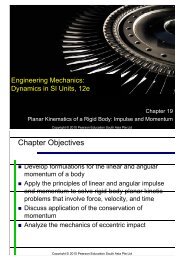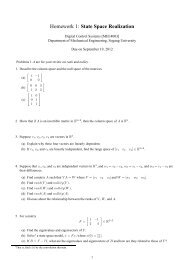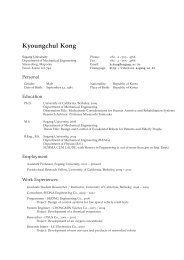Digital Control Systems [MEE 4003] - Kckong.info
Digital Control Systems [MEE 4003] - Kckong.info
Digital Control Systems [MEE 4003] - Kckong.info
Create successful ePaper yourself
Turn your PDF publications into a flip-book with our unique Google optimized e-Paper software.
2.2. LAPLACE TRANSFORMS AND TRANSFER FUNCTIONS 41<br />
‘ ’“”•<br />
– ‘ ’— — —”•<br />
˜ ‘ š› œ– •<br />
žŸ ¡›˜ • ¢£¤¥¦¤¥§ ¥–¨©–ª š©«¬¨«¥¤«® –¥¦ ¦–¯°¤¥§ ©–¤±®<br />
²¤§«¥³–ª¨« ´–¯°¤¥§ £©«¬µ ›©–¦®<br />
·¸µ¹¹«·¹¹— º »µ¼¼«·¹¹—¤ ¸µ¹¹«·¹¹— —µ¹¹«º¹¹¹<br />
·¸µ¹¹«·¹¹— · »µ¼¼«·¹¹—¤ ¸µ¹¹«·¹¹— —µ¹¹«º¹¹¹<br />
Figure 2.11: Natural frequency and damping ratio of a transfer function<br />
G(s) can be expressed in the following form:<br />
G(s) =<br />
3<br />
s 2 +2ζω n s+ω 2 n<br />
where ω n = 1, and ζ = 0.5. One can say that the transfer function has the natural<br />
frequency of1and the damping ratio of0.5.<br />
When a transfer function has more than two poles, it is not clear how the damping<br />
ratio and the natural frequency are defined. Originally the transfer function in (2.13) is<br />
obtained from a mass-spring-damper system, which follows a second-order linear differential<br />
equation 8 . Therefore, in a strict sense the damping ratio and the natural frequency<br />
can be defined only when the transfer function has two poles. In a general sense, ζ and<br />
ω n are defined for each pair of complex poles.<br />
Repeated poles<br />
Suppose that a transfer function,G(s), hasmdistinct poles andn−m repeated poles. By<br />
the partial fraction expansion, it can be expanded as<br />
m∑<br />
n−m<br />
k i<br />
∑ κ k<br />
G(s) = +<br />
s−p<br />
i=1 i (s−p m ) k+1<br />
k=1<br />
where k i ’s and κ k ’s are scalars, p i ’s are the distinct poles and p m is the repeated pole. If<br />
the system is under an impulse input, i.e.,U(s) = 1, the output is<br />
8 mÿ +cẏ +ky = u<br />
y(t) = L −1 {<br />
=<br />
m∑<br />
i=1<br />
m∑<br />
k i e pit +<br />
i=1<br />
n−m<br />
k i<br />
∑ κ k<br />
+<br />
s−p i (s−p m ) k+1}<br />
k=1<br />
n−m<br />
∑<br />
k=1<br />
α k t k e pmt<br />
<strong>Digital</strong> <strong>Control</strong> <strong>Systems</strong>, Sogang University<br />
Kyoungchul Kong


![Digital Control Systems [MEE 4003] - Kckong.info](https://img.yumpu.com/32606446/42/500x640/digital-control-systems-mee-4003-kckonginfo.jpg)
![Digital Control Systems [MEE 4003] - Kckong.info](https://img.yumpu.com/40221932/1/184x260/digital-control-systems-mee-4003-kckonginfo.jpg?quality=85)


